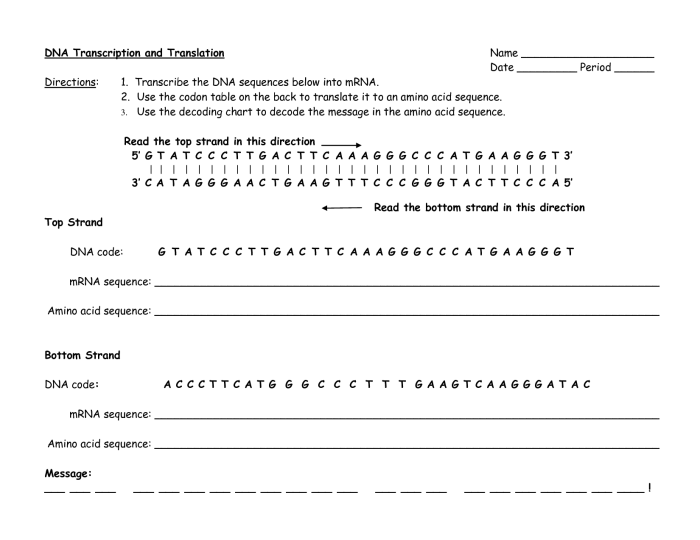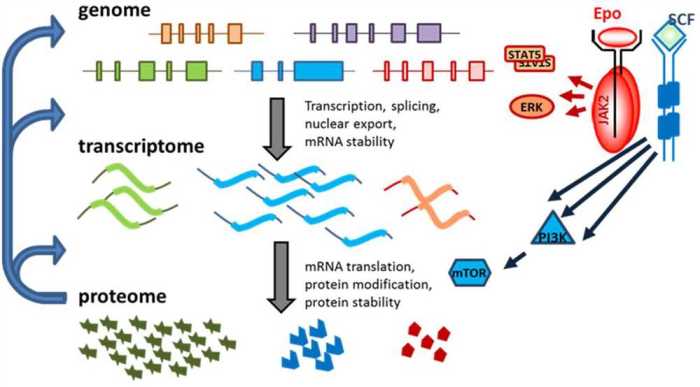Biology transcription and translation worksheet delves into the fundamental processes that govern the flow of genetic information within cells. These processes, essential for life, provide a comprehensive understanding of how DNA is transcribed into RNA and subsequently translated into proteins, the building blocks of life.
This worksheet offers an engaging exploration into the intricacies of transcription and translation, empowering students with a deeper comprehension of molecular biology.
Throughout this worksheet, we will embark on a journey to decipher the mechanisms of transcription and translation, uncovering the role of key players such as RNA polymerase and ribosomes. We will delve into the genetic code, examining the significance of codons and the consequences of mutations.
Furthermore, we will explore the diverse applications of transcription and translation, highlighting their impact on genetic engineering and medicine.
Transcription: Biology Transcription And Translation Worksheet

Transcription is the process of copying a gene’s DNA sequence into a complementary RNA molecule. It occurs in the nucleus of eukaryotic cells and the cytoplasm of prokaryotic cells. The enzyme RNA polymerase binds to the DNA template and synthesizes an RNA molecule by adding RNA nucleotides complementary to the DNA sequence.
Role of RNA Polymerase
- Binds to the promoter region of the DNA template.
- Unwinds the DNA helix and separates the strands.
- Synthesizes an RNA molecule by adding RNA nucleotides complementary to the DNA template.
- Terminates transcription when it reaches a terminator sequence.
Examples of Transcription Factors
- TFIID
- TFIIB
- TFIIH
Translation

Translation is the process of converting the genetic information in mRNA into a protein. It occurs in the cytoplasm of both eukaryotic and prokaryotic cells. The ribosome binds to the mRNA template and synthesizes a protein by adding amino acids in the order specified by the mRNA sequence.
Role of Ribosomes
- Bind to the mRNA template.
- Decode the mRNA sequence by reading the codons.
- Bind tRNA molecules that carry the corresponding amino acids.
- Catalyze the formation of peptide bonds between the amino acids.
Examples of Amino Acids
- Alanine
- Glycine
- Serine
Genetic Code
The genetic code is the set of rules that determines which amino acids are encoded by which codons. Codons are three-nucleotide sequences that occur in mRNA molecules. Each codon corresponds to a specific amino acid or a stop signal.
Role of Codons
- Specify which amino acid is added to the growing protein chain during translation.
- Determine the order of amino acids in the protein.
- Signal the end of protein synthesis when a stop codon is encountered.
Examples of Mutations
- Point mutations
- Insertions
- Deletions
Applications

Transcription and translation are essential processes for all living organisms. They are used for a variety of applications, including:
Genetic Engineering
- Creating genetically modified organisms (GMOs) with desirable traits.
- Developing new medical treatments.
- Producing industrial enzymes and other products.
Medicine, Biology transcription and translation worksheet
- Diagnosing and treating genetic diseases.
- Developing new drugs and vaccines.
- Understanding the molecular basis of cancer and other diseases.
Essential Questionnaire
What is the role of RNA polymerase in transcription?
RNA polymerase is the enzyme responsible for synthesizing RNA molecules by using DNA as a template. It binds to specific DNA sequences called promoters and unwinds the DNA helix, allowing RNA nucleotides to pair with their complementary DNA bases.
How do ribosomes contribute to translation?
Ribosomes are complex molecular machines that read the genetic code present in mRNA molecules and facilitate the assembly of amino acids into polypeptide chains. They bind to mRNA and tRNA molecules and catalyze the formation of peptide bonds between adjacent amino acids.
What is the significance of the genetic code?
The genetic code is a set of rules that governs the relationship between the sequence of nucleotides in DNA or RNA and the sequence of amino acids in proteins. It consists of codons, which are three-nucleotide sequences that specify a particular amino acid or a stop signal.

